Modern Warfare 2 theme by Killer3aw
Download: ModernWarfare2.p3t
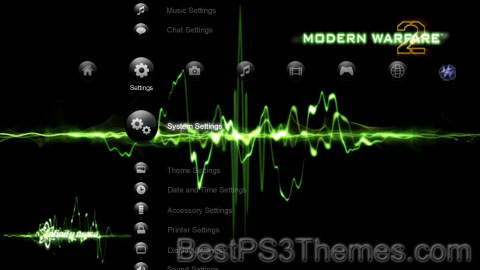
(13 backgrounds)
Redirect to:
This page is a redirect. The following categories are used to track and monitor this redirect:
|

The #1 spot for Playstation themes!
Modern Warfare 2 theme by Killer3aw
Download: ModernWarfare2.p3t

(13 backgrounds)
Redirect to:
This page is a redirect. The following categories are used to track and monitor this redirect:
|
Helghast Theme 2.70 by S-y-c-o
Download: Helghast.p3t
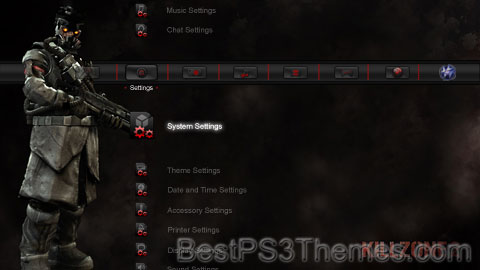
(10 backgrounds)
P3T Unpacker v0.12
Copyright (c) 2007. Anoop Menon
This program unpacks Playstation 3 Theme files (.p3t) so that you can touch-up an existing theme to your likings or use a certain wallpaper from it (as many themes have multiple). But remember, if you use content from another theme and release it, be sure to give credit!
Download for Windows: p3textractor.zip
Instructions:
Download p3textractor.zip from above. Extract the files to a folder with a program such as WinZip or WinRAR. Now there are multiple ways to extract the theme.
The first way is to simply open the p3t file with p3textractor.exe. If you don’t know how to do this, right click the p3t file and select Open With. Alternatively, open the p3t file and it will ask you to select a program to open with. Click Browse and find p3textractor.exe from where you previously extracted it to. It will open CMD and extract the theme to extracted.[filename]. After that, all you need to do for any future p3t files is open them and it will extract.
The second way is very simple. Just drag the p3t file to p3textractor.exe. It will open CMD and extract the theme to extracted.[filename].
For the third way, first put the p3t file you want to extract into the same folder as p3textractor.exe. Open CMD and browse to the folder with p3extractor.exe. Enter the following:
p3textractor filename.p3t [destination path]Replace filename with the name of the p3t file, and replace [destination path] with the name of the folder you want the files to be extracted to. A destination path is not required. By default it will extract to extracted.filename.
Worms Armageddon theme by Woobieizer
Download: WormsArmageddon.p3t
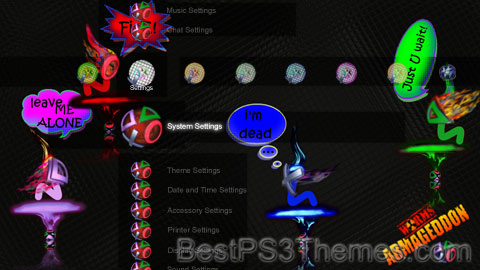
(5 backgrounds, HD only)
| Worms Armageddon | |
|---|---|
 | |
| Developer(s) |
|
| Publisher(s) | PC
Hasbro Interactive N64 and GBC Infogrames |
| Producer(s) | Martyn Brown |
| Programmer(s) | Karl Morton |
| Artist(s) | Dan Cartwright |
| Composer(s) | Bjørn Lynne |
| Series | Worms |
| Platform(s) | Microsoft Windows Dreamcast PlayStation Game Boy Color Nintendo 64 |
| Release | Windows Dreamcast, PlayStation Nintendo 64Game Boy Color |
| Genre(s) | Turn-based strategy |
| Mode(s) | Single-player, multiplayer |
Worms Armageddon is a 1999 turn-based strategy video game developed and published by Team17 as part of the Worms series. It was originally released for the Microsoft Windows operating system, and was later ported to the PlayStation, Dreamcast, Nintendo 64, and Game Boy Color. In the game, the player controls a team of up to eight earthworms tasked with defeating an opposing team using a wide range of weapons at their disposal. The game takes place on a destructible and customizable two-dimensional board and is characterized by cartoonish graphics and a unique brand of humour.
The third installment in the series, Worms Armageddon was originally developed as an expansion pack to Worms 2 (1997) and initially titled Wormageddon before it was released as a standalone game. As a result the game is very similar to Worms 2 but has a new single-player mode and adds a number of new content[5][6] as well as being released on a wider variety of platforms. Worms Armageddon was acclaimed by critics, who praised the refined gameplay and stylized graphics, and it has been featured in a number of "greatest games of all time" lists. Worms Armageddon on PC is still updated periodically, most recently in 2020. The game was succeeded by Worms World Party (2001), which added further content without drastic change[7] and which was the last 2D-based Worms game before the series moved to 3D.
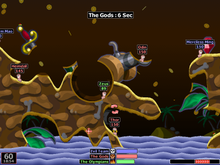
Gameplay is turn-based, with each team moving in sequence, which is determined randomly, across two-dimensional terrain. During a single turn, a team can only move one of their worms (unless an item that allows the team to select their worm is used). Worms can walk and jump, as well as (when the proper items are available) swing by rope, parachute, teleport, and bungee. The objective of a traditional match is to defeat all opposing teams by killing their worms, although in the campaign some missions have other objectives such as collecting a specific crate.[8]
Each worm begins the round with a specific amount of health, which is predefined by the chosen game options or by scripting in campaign levels. When hit with a weapon, the worm will lose health depending upon the power of the weapon and the directness of the hit.[8] A worm can be killed either by exploding after having its health reduced to zero or by being knocked into the water around and below the level.[9]
The game includes a wide variety of weapons, including melee, projectile, and explosive weapons, as well as airstrike-based attacks. Some are based on real-life arms, such as the shotgun, bazooka, and hand grenade; others are rather fanciful and cartoonish, such as the sheep, which serves as a mobile explosive, and the skunk, which releases poisonous gas. In a normal match, all teams begin with the same weapons, based on the chosen weapon set. Some weapons may not become available until a certain number of turns pass. Depending on the game options, additional weapons may randomly fall onto the terrain in airdropped and teleported crates. In addition to normal weapons, during team creation, each team chooses a special weapon which becomes available to them after a certain number of turns. The special weapons are more powerful than regular weapons and often offer special abilities; super weapons will rarely fall in weapon crates. These weapons are often based on cartoonish themes, such as the French Sheep Strike, and usually devastating in power.[8] In homage to the film Monty Python and the Holy Grail, one of the game weapons is a Holy Hand Grenade, with a sound-effect reminiscent of the Hallelujah chorus from Handel's Messiah.[10]
Worms Armageddon includes a series of training missions, a single-player campaign with premade missions, a deathmatch mode in which the player fights increasingly difficult and outnumbered battles against the computer,[9] local multiplayer, and online multiplayer.
Local multiplayer allows the player to select which teams participate in the battle as well as the number of worms and handicaps, which options and weapons are used, and the level to be played on. The matches can use any combination of human and computer teams, provided at least one team is human. Additionally, multiple worm teams can form an alliance for the match by selecting the same team color – they will still operate separately in movement rotation but share weapons and score. If multiple human players are using the same computer, the game functions in a hotseat mode.[8]
Online multiplayer is set up similarly to local multiplayer but allows the players to be at separate computers. Additionally, hotseat can be combined with online play, so multiple human players can use each computer.[8]
Worms Armageddon features a multiplayer Internet service called WormNet. This service allows one player to host a game online and others to join it. The host can choose settings such as the landscape and scheme. In the past, it used to keep a score and ranking system for the players.[10]
Worms Armageddon includes a very high level of customizability – in multiplayer games or skirmishes, the player can create custom game modes with preferred gameplay options and weapon sets. Regular options include starting health, whether the worms can move, how long a turn lasts, and sudden death options. Weapons settings include what weapons the teams start with, which weapons will fall in crates and how often, and how powerful individual weapons are. Worms Armageddon offers several levels of customizability outside of direct gameplay options.[8]
The game offers players the ability to create their own custom teams. Each team has its own name and includes eight individually named worms. The player can also change the team's special weapon, grave marker, flag, victory fanfare, and voice set. In addition to numerous defaults available, the game offers the ability to import custom voices.[8]
The game includes a random terrain generator, a basic terrain editor which allows the user to create the shape of the terrain with brushes, and a more complex terrain-import system which allows the user to import custom-made terrains in image format, which the game automatically converts into playable terrains.[8]
Worms Armageddon was originally intended to be an expansion pack to Worms 2, but it was eventually developed as a standalone game. It was intended to be the last game of the Worms franchise, but Worms creator Andy Davidson felt that it needed more content before being released, leading to the development of Worms World Party.[10] It was also going to be released under the name Wormageddon, but Team17 changed the name to Worms Armageddon because of close similarities to the name of the game Carmageddon.[11] It was released initially for PCs in 1999 in Europe and North America, published by Hasbro Interactive under the MicroProse brand.[12] The game was eventually ported to Dreamcast and PlayStation in December 1999, Game Boy Color in January 2000, and Nintendo 64 in March 2000. The Nintendo 64 version is one of the first Nintendo 64 games to feature a terrain editor and generator.[13] A Macintosh version was being developed by MacSoft, but it has since been cancelled.[citation needed] Worms Armageddon was produced by Martyn Brown and composed by Bjørn Lynne, Karl Morton was the game's lead programmer, and Dan Cartwright was the game's lead artist.[citation needed]
Worms Armageddon was initially released on the Steam platform for a limited time as the preorder bonus for Worms Revolution. The Steam release included all improvements from the previously-released updates. This release was made available on 12 September 2012.[14] Worms Armageddon was released onto the Steam store as a standalone game on 20 March 2013.[15]
Despite its age, Worms Armageddon still receives periodic updates, mainly from two programmers known as Deadcode and CyberShadow, recruited by Team17.[16] These updates address bugs and compatibility issues, and also add new features to the game, such as support for a greater number of worms in a match and support for arbitrarily-sized colour levels. The latest update was on 16 July 2020.[17]
| Aggregator | Score | ||||
|---|---|---|---|---|---|
| Dreamcast | GBC | N64 | PC | PS | |
| GameRankings | 81%[18] | 75%[19] | 84%[20] | 88%[21] | 83%[22] |
| Publication | Score | ||||
|---|---|---|---|---|---|
| Dreamcast | GBC | N64 | PC | PS | |
| CNET Gamecenter | 8/10[23] | N/A | 8/10[24] | 7/10[25] | 8/10[26] |
| Computer Gaming World | N/A | N/A | N/A | 4/5[27] | N/A |
| Electronic Gaming Monthly | N/A | 2/10[28] | N/A | N/A | 9.25/10[29][a] |
| Game Informer | N/A | N/A | N/A | 8/10[30] | 8/10[31] |
| GameFan | N/A | N/A | 95%[32][b] (G.H.) 89%[33] | 4.5/5[34] | 90%[35] |
| GameRevolution | B[36] | N/A | N/A | A−[37] | N/A |
| GameSpot | 7.8/10[38] | N/A | 7.7/10[39] | 9.1/10[9] | 7.9/10[40] |
| GameSpy | 5.5/10[41] | N/A | N/A | N/A | N/A |
| IGN | 9/10[42] | 6/10[43] | 8.7/10[44] | 8.6/10[45] | 7.5/10[46] |
| Next Generation | N/A | N/A | 3/5[47] | N/A | N/A |
| Nintendo Power | N/A | N/A | 7.4/10[48] | N/A | N/A |
| Official U.S. PlayStation Magazine | N/A | N/A | N/A | N/A | 3.5/5[49] |
| PC Accelerator | N/A | N/A | N/A | 7/10[50] | N/A |
| PC Gamer (UK) | N/A | N/A | N/A | 90%[51] | N/A |
| Official Dreamcast Magazine UK | 8/10[52] | N/A | N/A | N/A | N/A |
The game received favorable reviews on all platforms. The main element across all the versions of the game that the critics considered praiseworthy is the gameplay.
The PC version was critically successful. Whilst writing that veterans of Worms 2 would find the game to be similar, Greg Kasavin of GameSpot praised the game for being easy to play and control and humorous and the game's graphics, physics, and seemingly endless customization as well as the game's WormNet. He also likened the single-player missions to the classic game of Lemmings in that the missions often required the player to precisely utilize a limited supply of weapons and tools to accomplish the objective. Among his only criticisms are that the AI-controlled worms do not utilize their full arsenals and that the player would wish that there were more weapons, more diverse graphics and sound, and more content.[9] Matthew Pierce of PC Gamer UK commended Team17 for addressing the problems of single-player (i.e. the missions and AI) that the original Worms and Worms 2 had always been criticized for.[51] Chris Hudak of The Electric Playground gave it a perfect ten, calling it "a gaming masterpiece."[53] Tom Chick of GamePro said, "For all its similarities to previous cans of Worms, Armageddon is still a classic example of the joy of computer gaming. It's right up there with rare, benevolent gems like RollerCoaster Tycoon and Grim Fandango--games that'll make you smile and even giggle like a schoolgirl. And when it comes right down to it, I'd rather giggle for an hour than spend all day grimly swinging away at orcs or aiming plasma weapons."[54][c] Dan Toose of Hyper gave it 87%, calling it "A fitting end to an excellent series of games [and a] perfect blend of serious strategy and ludicrous humour."[55] Nick Smith of AllGame gave it four stars out of five, calling it "very, very addictive".[56] Cindy Vanous of Computer Games Strategy Plus gave it a similar score of four stars out of five, saying, "In short, it seems that Team 17 [sic] figured out every detail that might have detracted even slightly from Worms 2, then recreated the game without those tiny flaws. The result is eminently playable and often hysterical—in fact, the only thing serious in Armageddon is its strategy."[57]
The Dreamcast version's reception was positive. Johnny Liu of GameRevolution praised the version for its "addictive" gameplay, its loads of personality, and not having to save money to buy multiple controllers for multiplayer, but criticized the version for the lack of Internet support, reduced customizations compared to the PC version, and the lack of a multiple-controller option.[36] On the contrary, Ben Stahl of GameSpot praised the multiple controller ports as well as multiplayer for being fast-paced and turned into a "barrage of havoc", but criticized the single-player for the AI-controlled worms' nearly perfect accuracy and the length of time that it takes for such worms to complete their turns. He also pointed out that the worms' high-pitched voices are "only mildly cute" and can potentially be annoying, but praised the soundtracks for lending in realism to an otherwise unrealistic experience and the background music for helping players stay on task.[38] Joel Durham Jr. of AllGame gave it four stars out of five, saying, "With fabulous gameplay and a stunning amount of options, Worms: Armageddon [sic] is sure to please. The sheer amount of effort that went into this title is commendable in its own right. Every development house could learn something by taking a few pages from Team 17's [sic] book."[58] Cam Shea of Hyper gave it 79%, saying, "if this is the kind of no frills PC port we can expect for the Dreamcast, don't toss out your N64 just yet. You may just need it if you want to play the best version of Worms Armageddon on the block."[59]
Jeff Nash of The Electric Playground gave the PlayStation version nine out of ten almost a year after it was released, calling it "a wonderful breath of fresh air for strategy gaming. With its carefree, happy-go-lucky attitude, it's easy to just fall in love with this title. With a multi-player mode thrown in for good measure, this game has a fantastic one-two punch of great gameplay, and an easy setup for sharing it with others, making it a very fun experience. With a liberal dose of humor present as well, this game is a wonderful romp through the grueling world of worm warfare."[60] However, Mark Kanarick of AllGame gave it two-and-a-half stars out of five, saying, "Although not the best version of Worms, Worms: Armageddon for the PlayStation is a good party game and an occasionally fun single-player game."[61]
The Game Boy Color port slightly favorable reviews. Concluding that the port is an "abridged edition of the overall game", Craig Harris of IGN criticized the version's great lack of the PC version's features (e.g. weapons) and personality and pointed out its "quirky" graphics. The reviewer felt that the game's front end was "extremely thrown together". He concluded that it was still fun to play.[43] Hudak of The Electric Playground gave it seven out of ten, similarly criticized the lack of weapons, and also criticized the lack of soundbites and complete lack of voices and what he perceived to be "microscopic" worms that are tough for the eye to see. He did, however, praise the terrain and physics engine for being well translated from the other versions of the game.[62] Jason White of AllGame gave it three stars out of five, saying that it "has so much going for it in the fun department that the odd controls and sometimes hard to navigate terrain will be easily forgotten. Go out and give this one a try. It's well worth the time."[63]
Many publications gave the Nintendo 64 version favorable reviews while it was still in development months before its U.S. release date.[48] Lou Gubrious of GamePro said that the game's European import "won't dazzle you with graphics or stun you with sound, but it will suck you in with its simple playability. Before you know it, you'll glance up from the TV only to be greeted by the sun, rising like an eye-piercing, flaming disk punishing you for staying up all night again."[64][d] Arthur Adam of Hyper gave the same Nintendo 64 version 89%, saying, "This strategy game has proved to be dynamite on the N64, making it possibly the best multi-player title for the console."[65] Marin Kitts of N64 Magazine gave it 85%, calling it "A welcome conversion of one of the most original four-player games you can buy."[66] However, Michael Wolf of NextGen called the same console version "A good rental if you're planning a gaming party, but for day-to-day gaming, these annelids just don't cut it."[47]
The PlayStation version received a "Gold" sales award from the Entertainment and Leisure Software Publishers Association (ELSPA),[67] indicating sales of at least 200,000 units in the UK.[68]
The PlayStation and Dreamcast versions won the award for "Best Strategy Game" at the EGM Game Blast Awards.[69] The PC version was nominated for the same category at the Sixth Annual PC Gamer Awards, which went to Sid Meier's Alpha Centauri. The staff wrote that the game "put up one hell of a fight [for the award] and should not be overlooked by fans of the genre."[70] The console versions were nominated for the same category at GameSpot's Best and Worst of 2000 Awards, which went to Ogre Battle 64.[71]
Worms Armageddon has been placed on several lists of the greatest games of all time. Digital Spy ranked Worms Armageddon at No. 18 on their list of the top 20 Nintendo 64 games of all time.[72] In 2014, GamesRadar+ ranked the game at No. 13 on their list of the top 50 PlayStation games of all time.[73] In 2015, they also ranked it at No. 68 on their list of the top 100 video games of all time.[74] In 2014, Slant Magazine ranked the game at No. 100 on their similar list.[75] TechRadar listed the game as one of their favourite PC games of all time.[76]
Team17 chose to base the source code of the 2016 game Worms W.M.D entirely on that of Worms Armageddon, because fans frequently told them upon questioning that Worms Armageddon was their favourite game in the series.[77] Additionally, the 2009 game Worms 2: Armageddon was named in honor of Worms Armageddon despite not being a direct sequel.
In 2022, the PlayStation versions of Worms Armageddon and Worms World Party were added to the PlayStation Store as part of the first batch of downloadable PlayStation titles; the games run on emulation on the PlayStation 4 and PlayStation 5, but do not feature trophies.
Fabula Nova Crystallis v2.5 theme by Clent
Download: FabulaNovaCrystallisv25.p3t

(2 backgrounds)
P3T Unpacker v0.12
Copyright (c) 2007. Anoop Menon
This program unpacks Playstation 3 Theme files (.p3t) so that you can touch-up an existing theme to your likings or use a certain wallpaper from it (as many themes have multiple). But remember, if you use content from another theme and release it, be sure to give credit!
Download for Windows: p3textractor.zip
Instructions:
Download p3textractor.zip from above. Extract the files to a folder with a program such as WinZip or WinRAR. Now there are multiple ways to extract the theme.
The first way is to simply open the p3t file with p3textractor.exe. If you don’t know how to do this, right click the p3t file and select Open With. Alternatively, open the p3t file and it will ask you to select a program to open with. Click Browse and find p3textractor.exe from where you previously extracted it to. It will open CMD and extract the theme to extracted.[filename]. After that, all you need to do for any future p3t files is open them and it will extract.
The second way is very simple. Just drag the p3t file to p3textractor.exe. It will open CMD and extract the theme to extracted.[filename].
For the third way, first put the p3t file you want to extract into the same folder as p3textractor.exe. Open CMD and browse to the folder with p3extractor.exe. Enter the following:
p3textractor filename.p3t [destination path]Replace filename with the name of the p3t file, and replace [destination path] with the name of the folder you want the files to be extracted to. A destination path is not required. By default it will extract to extracted.filename.
Rings of Saturn theme by Dennis “F-Rott” Ferrand
Download: RingsofSaturn.p3t
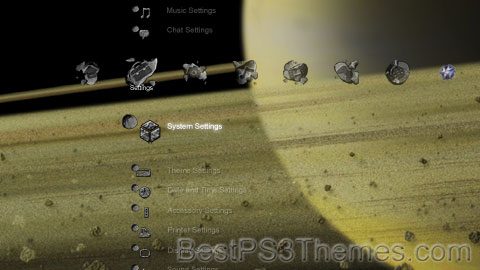
(3 backgrounds)

The rings of Saturn are the most extensive and complex ring system of any planet in the Solar System. They consist of countless small particles, ranging in size from micrometers to meters,[1] that orbit around Saturn. The ring particles are made almost entirely of water ice, with a trace component of rocky material. There is still no consensus as to their mechanism of formation. Although theoretical models indicated that the rings were likely to have formed early in the Solar System's history,[2] newer data from Cassini suggested they formed relatively late.[3]
Although reflection from the rings increases Saturn's brightness, they are not visible from Earth with unaided vision. In 1610, the year after Galileo Galilei turned a telescope to the sky, he became the first person to observe Saturn's rings, though he could not see them well enough to discern their true nature. In 1655, Christiaan Huygens was the first person to describe them as a disk surrounding Saturn.[4] The concept that Saturn's rings are made up of a series of tiny ringlets can be traced to Pierre-Simon Laplace,[4] although true gaps are few – it is more correct to think of the rings as an annular disk with concentric local maxima and minima in density and brightness.[2] On the scale of the clumps within the rings there is much empty space.
The rings have numerous gaps where particle density drops sharply: two opened by known moons embedded within them, and many others at locations of known destabilizing orbital resonances with the moons of Saturn. Other gaps remain unexplained. Stabilizing resonances, on the other hand, are responsible for the longevity of several rings, such as the Titan Ringlet and the G Ring.
Well beyond the main rings is the Phoebe ring, which is presumed to originate from Phoebe and thus share its retrograde orbital motion. It is aligned with the plane of Saturn's orbit. Saturn has an axial tilt of 27 degrees, so this ring is tilted at an angle of 27 degrees to the more visible rings orbiting above Saturn's equator.

In September 2023, astronomers reported studies suggesting that the rings of Saturn may have resulted from the collision of two moons "a few hundred million years ago".[5][6]
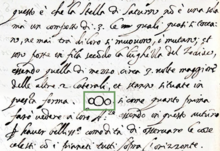
Galileo Galilei was the first to observe the rings of Saturn in 1610 using his telescope, but was unable to identify them as such. He wrote to the Duke of Tuscany that "The planet Saturn is not alone, but is composed of three, which almost touch one another and never move nor change with respect to one another. They are arranged in a line parallel to the zodiac, and the middle one (Saturn itself) is about three times the size of the lateral ones."[7] He also described the rings as Saturn's "ears". In 1612 the Earth passed through the plane of the rings and they became invisible. Mystified, Galileo remarked "I do not know what to say in a case so surprising, so unlooked for and so novel."[4] He mused, "Has Saturn swallowed his children?" — referring to the myth of the Titan Saturn devouring his offspring to forestall the prophecy of them overthrowing him.[7][8] He was further confused when the rings again became visible in 1613.[4]
Early astronomers used anagrams as a form of commitment scheme to lay claim to new discoveries before their results were ready for publication. Galileo used the anagram "smaismrmilmepoetaleumibunenugttauiras" for Altissimum planetam tergeminum observavi ("I have observed the most distant planet to have a triple form") for discovering the rings of Saturn.[9][10][11]
In 1657 Christopher Wren became Professor of Astronomy at Gresham College, London. He had been making observations of the planet Saturn from around 1652 with the aim of explaining its appearance. His hypothesis was written up in De corpore saturni, in which he came close to suggesting the planet had a ring. However, Wren was unsure whether the ring was independent of the planet, or physically attached to it. Before Wren's hypothesis was published Christiaan Huygens presented his hypothesis of the rings of Saturn. Immediately Wren recognised this as a better hypothesis than his own and De corpore saturni was never published. Robert Hooke was another early observer of the rings of Saturn, and noted the casting of shadows on the rings.[12]

Huygens began grinding lenses with his father Constantijn in 1655 and was able to observe Saturn with greater detail using a 43× power refracting telescope that he designed himself. He was the first to suggest that Saturn was surrounded by a ring detached from the planet, and famously published the anagram: "aaaaaaacccccdeeeeeghiiiiiiillllmmnnnnnnnnnooooppqrrstttttuuuuu".[13] Three years later, he revealed it to mean Annulo cingitur, tenui, plano, nusquam coherente, ad eclipticam inclinato ("[Saturn] is surrounded by a thin, flat, ring, nowhere touching [the body of the planet], inclined to the ecliptic").[14][4][15] He published his ring hypothesis in Systema Saturnium (1659) which also included his discovery of Saturn's moon, Titan, as well as the first clear outline of the dimensions of the Solar System.[16]
In 1675, Giovanni Domenico Cassini determined that Saturn's ring was composed of multiple smaller rings with gaps between them;[17] the largest of these gaps was later named the Cassini Division. This division is a 4,800-kilometre-wide (3,000 mi) region between the A ring and B Ring.[18]
In 1787, Pierre-Simon Laplace proved that a uniform solid ring would be unstable and suggested that the rings were composed of a large number of solid ringlets.[19][4][20]
In 1859, James Clerk Maxwell demonstrated that a nonuniform solid ring, solid ringlets or a continuous fluid ring would also not be stable, indicating that the ring must be composed of numerous small particles, all independently orbiting Saturn.[21][20] Later, Sofia Kovalevskaya also found that Saturn's rings cannot be liquid ring-shaped bodies.[22][23] Spectroscopic studies of the rings which were carried out independently in 1895 by James Keeler of the Allegheny Observatory and by Aristarkh Belopolsky of the Pulkovo Observatory showed that Maxwell's analysis was correct.[24][25]
Four robotic spacecraft have observed Saturn's rings from the vicinity of the planet. Pioneer 11's closest approach to Saturn occurred in September 1979 at a distance of 20,900 km (13,000 mi).[26] Pioneer 11 was responsible for the discovery of the F ring.[26] Voyager 1's closest approach occurred in November 1980 at a distance of 64,200 km (39,900 mi).[27] A failed photopolarimeter prevented Voyager 1 from observing Saturn's rings at the planned resolution; nevertheless, images from the spacecraft provided unprecedented detail of the ring system and revealed the existence of the G ring.[28] Voyager 2's closest approach occurred in August 1981 at a distance of 41,000 km (25,000 mi).[27] Voyager 2's working photopolarimeter allowed it to observe the ring system at higher resolution than Voyager 1, and to thereby discover many previously unseen ringlets.[29] Cassini spacecraft entered into orbit around Saturn in July 2004.[30] Cassini's images of the rings are the most detailed to-date, and are responsible for the discovery of yet more ringlets.[31]
The rings are named alphabetically in the order they were discovered[32] (A and B in 1675 by Giovanni Domenico Cassini, C in 1850 by William Cranch Bond and his son George Phillips Bond, D in 1933 by Nikolai P. Barabachov and B. Semejkin, E in 1967 by Walter A. Feibelman, F in 1979 by Pioneer 11, and G in 1980 by Voyager 1). The main rings are, working outward from the planet, C, B and A, with the Cassini Division, the largest gap, separating Rings B and A. Several fainter rings were discovered more recently. The D Ring is exceedingly faint and closest to the planet. The narrow F Ring is just outside the A Ring. Beyond that are two far fainter rings named G and E. The rings show a tremendous amount of structure on all scales, some related to perturbations by Saturn's moons, but much unexplained.[32]
In September 2023, astronomers reported studies suggesting that the rings of Saturn may have resulted from the collision of two moons "a few hundred million years ago".[5][6]
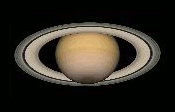
Saturn's axial tilt is 26.7°, meaning that widely varying views of the rings, of which the visible ones occupy its equatorial plane, are obtained from Earth at different times.[33] Earth makes passes through the ring plane every 13 to 15 years, about every half Saturn year, and there are about equal chances of either a single or three crossings occurring in each such occasion. The most recent ring plane crossings were on 22 May 1995, 10 August 1995, 11 February 1996 and 4 September 2009; upcoming events will occur on 23 March 2025, 15 October 2038, 1 April 2039 and 9 July 2039. Favorable ring plane crossing viewing opportunities (with Saturn not close to the Sun) only come during triple crossings.[34][35][36]
Saturn's equinoxes, when the Sun passes through the ring plane, are not evenly spaced. The sun passes south to north through the ring plane when Saturn's heliocentric longitude is 173.6 degrees (e.g. 11 August 2009), about the time Saturn crosses from Leo to Virgo. 15.7 years later Saturn's longitude reaches 353.6 degrees and the sun passes to the south side of the ring plane. On each orbit the Sun is north of the ring plane for 15.7 Earth years, then south of the plane for 13.7 years.[a] Dates for north-to-south crossings include 19 November 1995 and 6 May 2025, with south-to-north crossings on 11 August 2009 and 23 January 2039.[38] During the period around an equinox the illumination of most of the rings is greatly reduced, making possible unique observations highlighting features that depart from the ring plane.[39]
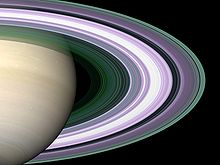
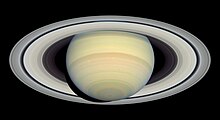
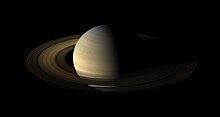
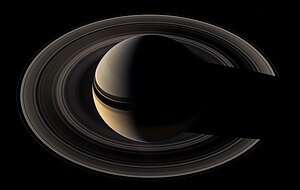
The dense main rings extend from 7,000 km (4,300 mi) to 80,000 km (50,000 mi) away from Saturn's equator, whose radius is 60,300 km (37,500 mi) (see Major subdivisions). With an estimated local thickness of as little as 10 metres (32' 10")[40] and as much as 1 km (1093 yards),[41] they are composed of 99.9% pure water ice with a smattering of impurities that may include tholins or silicates.[42] The main rings are primarily composed of particles smaller than 10 m.[43]
Cassini directly measured the mass of the ring system via their gravitational effect during its final set of orbits that passed between the rings and the cloud tops, yielding a value of 1.54 (± 0.49) × 1019 kg, or 0.41 ± 0.13 Mimas masses.[3] This is around two-thirds the mass of the Earth's entire Antarctic ice sheet, spread across a surface area 80 times larger than that of Earth.[44][45] The estimate is close to the value of 0.40 Mimas masses derived from Cassini observations of density waves in the A, B and C rings.[3] It is a small fraction of the total mass of Saturn (about 0.25 ppb). Earlier Voyager observations of density waves in the A and B rings and an optical depth profile had yielded a mass of about 0.75 Mimas masses,[46] with later observations and computer modeling suggesting that was an underestimate.[47]
Although the largest gaps in the rings, such as the Cassini Division and Encke Gap, can be seen from Earth, the Voyager spacecraft discovered that the rings have an intricate structure of thousands of thin gaps and ringlets. This structure is thought to arise, in several different ways, from the gravitational pull of Saturn's many moons. Some gaps are cleared out by the passage of tiny moonlets such as Pan,[48] many more of which may yet be discovered, and some ringlets seem to be maintained by the gravitational effects of small shepherd satellites (similar to Prometheus and Pandora's maintenance of the F ring). Other gaps arise from resonances between the orbital period of particles in the gap and that of a more massive moon further out; Mimas maintains the Cassini Division in this manner.[49] Still more structure in the rings consists of spiral waves raised by the inner moons' periodic gravitational perturbations at less disruptive resonances.[citation needed] Data from the Cassini space probe indicate that the rings of Saturn possess their own atmosphere, independent of that of the planet itself. The atmosphere is composed of molecular oxygen gas (O2) produced when ultraviolet light from the Sun interacts with water ice in the rings. Chemical reactions between water molecule fragments and further ultraviolet stimulation create and eject, among other things, O2. According to models of this atmosphere, H2 is also present. The O2 and H2 atmospheres are so sparse that if the entire atmosphere were somehow condensed onto the rings, it would be about one atom thick.[50] The rings also have a similarly sparse OH (hydroxide) atmosphere. Like the O2, this atmosphere is produced by the disintegration of water molecules, though in this case the disintegration is done by energetic ions that bombard water molecules ejected by Saturn's moon Enceladus. This atmosphere, despite being extremely sparse, was detected from Earth by the Hubble Space Telescope.[51] Saturn shows complex patterns in its brightness.[52] Most of the variability is due to the changing aspect of the rings,[53][54] and this goes through two cycles every orbit. However, superimposed on this is variability due to the eccentricity of the planet's orbit that causes the planet to display brighter oppositions in the northern hemisphere than it does in the southern.[55]
In 1980, Voyager 1 made a fly-by of Saturn that showed the F ring to be composed of three narrow rings that appeared to be braided in a complex structure; it is now known that the outer two rings consist of knobs, kinks and lumps that give the illusion of braiding, with the less bright third ring lying inside them.[citation needed]
New images of the rings taken around the 11 August 2009 equinox of Saturn by NASA's Cassini spacecraft have shown that the rings extend significantly out of the nominal ring plane in a few places. This displacement reaches as much as 4 km (2.5 mi) at the border of the Keeler Gap, due to the out-of-plane orbit of Daphnis, the moon that creates the gap.[56]
Estimates of the age of Saturn's rings vary widely, depending on the approach used. They have been considered to possibly be very old, dating to the formation of Saturn itself. However, data from Cassini suggest they are much younger, having most likely formed within the last 100 million years, and may thus be between 10 million and 100 million years old.[3][57] This recent origin scenario is based on a new, low mass estimate, modeling of the rings' dynamical evolution, and measurements of the flux of interplanetary dust, which feed into an estimate of the rate of ring darkening over time.[3] Since the rings are continually losing material, they would have been more massive in the past than at present.[3] The mass estimate alone is not very diagnostic, since high mass rings that formed early in the Solar System's history would have evolved by now to a mass close to that measured.[3] Based on current depletion rates, they may disappear in 300 million years.[58][59]
There are two main theories regarding the origin of Saturn's inner rings. A theory originally proposed by Édouard Roche in the 19th century, is that the rings were once a moon of Saturn (named Veritas, after a Roman goddess who hid in a well). According to the theory the moon's orbit decayed until it was close enough to be ripped apart by tidal forces (see Roche limit).[60] Numerical simulations carried out in 2022 support this theory; the authors of that study proposed the name "Chrysalis" for the destroyed moon.[61] A variation on this theory is that this moon disintegrated after being struck by a large comet or asteroid.[62] The second theory is that the rings were never part of a moon, but are instead left over from the original nebular material from which Saturn formed.[citation needed]

A more traditional version of the disrupted-moon theory is that the rings are composed of debris from a moon 400 to 600 km (200 to 400 miles) in diameter, slightly larger than Mimas. The last time there were collisions large enough to be likely to disrupt a moon that large was during the Late Heavy Bombardment some four billion years ago.[63]
A more recent variant of this type of theory by R. M. Canup is that the rings could represent part of the remains of the icy mantle of a much larger, Titan-sized, differentiated moon that was stripped of its outer layer as it spiraled into the planet during the formative period when Saturn was still surrounded by a gaseous nebula.[64][65] This would explain the scarcity of rocky material within the rings. The rings would initially have been much more massive (≈1,000 times) and broader than at present; material in the outer portions of the rings would have coalesced into the moons of Saturn out to Tethys, also explaining the lack of rocky material in the composition of most of these moons.[65] Subsequent collisional or cryovolcanic evolution of Enceladus might then have caused selective loss of ice from this moon, raising its density to its current value of 1.61 g/cm3, compared to values of 1.15 for Mimas and 0.97 for Tethys.[65]
The idea of massive early rings was subsequently extended to explain the formation of Saturn's moons out to Rhea.[66] If the initial massive rings contained chunks of rocky material (>100 km; 60 miles across) as well as ice, these silicate bodies would have accreted more ice and been expelled from the rings, due to gravitational interactions with the rings and tidal interaction with Saturn, into progressively wider orbits. Within the Roche limit, bodies of rocky material are dense enough to accrete additional material, whereas less-dense bodies of ice are not. Once outside the rings, the newly formed moons could have continued to evolve through random mergers. This process may explain the variation in silicate content of Saturn's moons out to Rhea, as well as the trend towards less silicate content closer to Saturn. Rhea would then be the oldest of the moons formed from the primordial rings, with moons closer to Saturn being progressively younger.[66]
The brightness and purity of the water ice in Saturn's rings have also been cited as evidence that the rings are much younger than Saturn,[57] as the infall of meteoric dust would have led to a darkening of the rings. However, new research indicates that the B Ring may be massive enough to have diluted infalling material and thus avoided substantial darkening over the age of the Solar System. Ring material may be recycled as clumps form within the rings and are then disrupted by impacts. This would explain the apparent youth of some of the material within the rings.[67] Evidence suggesting a recent origin of the C ring has been gathered by researchers analyzing data from the Cassini Titan Radar Mapper, which focused on analyzing the proportion of rocky silicates within this ring. If much of this material was contributed by a recently disrupted centaur or moon, the age of this ring could be on the order of 100 million years or less. On the other hand, if the material came primarily from micrometeoroid influx, the age would be closer to a billion years.[68]
The Cassini UVIS team, led by Larry Esposito, used stellar occultation to discover 13 objects, ranging from 27 metres (89') to 10 km (6 miles) across, within the F ring. They are translucent, suggesting they are temporary aggregates of ice boulders a few meters across. Esposito believes this to be the basic structure of the Saturnian rings, particles clumping together, then being blasted apart.[69]
Research based on rates of infall into Saturn favors a younger ring system age of hundreds of millions of years. Ring material is continually spiraling down into Saturn; the faster this infall, the shorter the lifetime of the ring system. One mechanism involves gravity pulling electrically charged water ice grains down from the rings along planetary magnetic field lines, a process termed 'ring rain'. This flow rate was inferred to be 432–2870 kg/s using ground-based Keck telescope observations; as a consequence of this process alone, the rings will be gone in ~292+818
−124 million years.[70] While traversing the gap between the rings and planet in September 2017, the Cassini spacecraft detected an equatorial flow of charge-neutral material from the rings to the planet of 4,800–44,000 kg/s.[71] Assuming this influx rate is stable, adding it to the continuous 'ring rain' process implies the rings may be gone in under 100 million years.[70][72]
The densest parts of the Saturnian ring system are the A and B Rings, which are separated by the Cassini Division (discovered in 1675 by Giovanni Domenico Cassini). Along with the C Ring, which was discovered in 1850 and is similar in character to the Cassini Division, these regions constitute the main rings. The main rings are denser and contain larger particles than the tenuous dusty rings. The latter include the D Ring, extending inward to Saturn's cloud tops, the G and E Rings and others beyond the main ring system. These diffuse rings are characterised as "dusty" because of the small size of their particles (often about a μm); their chemical composition is, like the main rings, almost entirely water ice. The narrow F Ring, just off the outer edge of the A Ring, is more difficult to categorize; parts of it are very dense, but it also contains a great deal of dust-size particles.

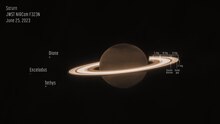
The Official RPJC 10 Point Female Rating Scale theme by Ron Pinkney
Download: OfficialRPJC10PFRS.p3t

(12 backgrounds)
P3T Unpacker v0.12
Copyright (c) 2007. Anoop Menon
This program unpacks Playstation 3 Theme files (.p3t) so that you can touch-up an existing theme to your likings or use a certain wallpaper from it (as many themes have multiple). But remember, if you use content from another theme and release it, be sure to give credit!
Download for Windows: p3textractor.zip
Instructions:
Download p3textractor.zip from above. Extract the files to a folder with a program such as WinZip or WinRAR. Now there are multiple ways to extract the theme.
The first way is to simply open the p3t file with p3textractor.exe. If you don’t know how to do this, right click the p3t file and select Open With. Alternatively, open the p3t file and it will ask you to select a program to open with. Click Browse and find p3textractor.exe from where you previously extracted it to. It will open CMD and extract the theme to extracted.[filename]. After that, all you need to do for any future p3t files is open them and it will extract.
The second way is very simple. Just drag the p3t file to p3textractor.exe. It will open CMD and extract the theme to extracted.[filename].
For the third way, first put the p3t file you want to extract into the same folder as p3textractor.exe. Open CMD and browse to the folder with p3extractor.exe. Enter the following:
p3textractor filename.p3t [destination path]Replace filename with the name of the p3t file, and replace [destination path] with the name of the folder you want the files to be extracted to. A destination path is not required. By default it will extract to extracted.filename.
Street Fighter Forever 2 theme by Ron Pinkney
Download: StreetFighterForever2.p3t
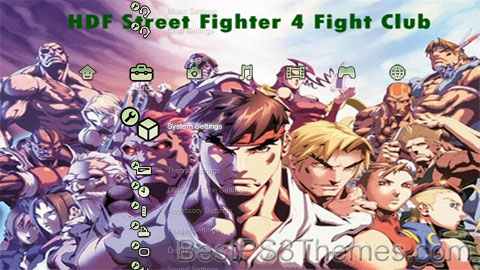
(2 backgrounds)
P3T Unpacker v0.12
Copyright (c) 2007. Anoop Menon
This program unpacks Playstation 3 Theme files (.p3t) so that you can touch-up an existing theme to your likings or use a certain wallpaper from it (as many themes have multiple). But remember, if you use content from another theme and release it, be sure to give credit!
Download for Windows: p3textractor.zip
Instructions:
Download p3textractor.zip from above. Extract the files to a folder with a program such as WinZip or WinRAR. Now there are multiple ways to extract the theme.
The first way is to simply open the p3t file with p3textractor.exe. If you don’t know how to do this, right click the p3t file and select Open With. Alternatively, open the p3t file and it will ask you to select a program to open with. Click Browse and find p3textractor.exe from where you previously extracted it to. It will open CMD and extract the theme to extracted.[filename]. After that, all you need to do for any future p3t files is open them and it will extract.
The second way is very simple. Just drag the p3t file to p3textractor.exe. It will open CMD and extract the theme to extracted.[filename].
For the third way, first put the p3t file you want to extract into the same folder as p3textractor.exe. Open CMD and browse to the folder with p3extractor.exe. Enter the following:
p3textractor filename.p3t [destination path]Replace filename with the name of the p3t file, and replace [destination path] with the name of the folder you want the files to be extracted to. A destination path is not required. By default it will extract to extracted.filename.
Wolf theme by Drace Karaki
Download: Wolf.p3t
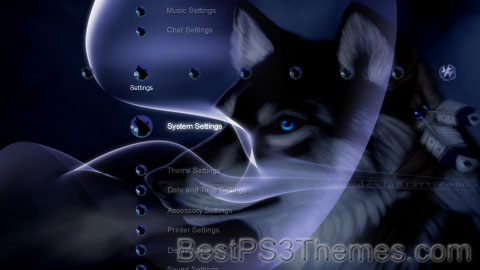
(1 background)
P3T Unpacker v0.12
Copyright (c) 2007. Anoop Menon
This program unpacks Playstation 3 Theme files (.p3t) so that you can touch-up an existing theme to your likings or use a certain wallpaper from it (as many themes have multiple). But remember, if you use content from another theme and release it, be sure to give credit!
Download for Windows: p3textractor.zip
Instructions:
Download p3textractor.zip from above. Extract the files to a folder with a program such as WinZip or WinRAR. Now there are multiple ways to extract the theme.
The first way is to simply open the p3t file with p3textractor.exe. If you don’t know how to do this, right click the p3t file and select Open With. Alternatively, open the p3t file and it will ask you to select a program to open with. Click Browse and find p3textractor.exe from where you previously extracted it to. It will open CMD and extract the theme to extracted.[filename]. After that, all you need to do for any future p3t files is open them and it will extract.
The second way is very simple. Just drag the p3t file to p3textractor.exe. It will open CMD and extract the theme to extracted.[filename].
For the third way, first put the p3t file you want to extract into the same folder as p3textractor.exe. Open CMD and browse to the folder with p3extractor.exe. Enter the following:
p3textractor filename.p3t [destination path]Replace filename with the name of the p3t file, and replace [destination path] with the name of the folder you want the files to be extracted to. A destination path is not required. By default it will extract to extracted.filename.
Final Fantasy VII Advent Children theme by Nic3 9uy
Download: FFVIIAdventChildren_5.p3t

(14 backgrounds)
Redirect to:
Abstract_Gun theme by WhiteGeneral246
Download: AbstractGun.p3t
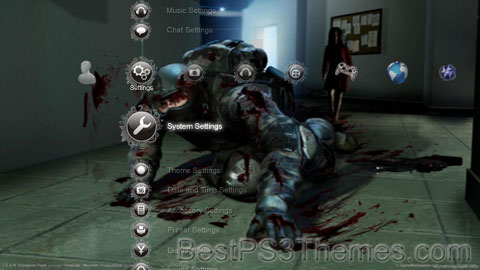
(4 backgrounds)
P3T Unpacker v0.12
Copyright (c) 2007. Anoop Menon
This program unpacks Playstation 3 Theme files (.p3t) so that you can touch-up an existing theme to your likings or use a certain wallpaper from it (as many themes have multiple). But remember, if you use content from another theme and release it, be sure to give credit!
Download for Windows: p3textractor.zip
Instructions:
Download p3textractor.zip from above. Extract the files to a folder with a program such as WinZip or WinRAR. Now there are multiple ways to extract the theme.
The first way is to simply open the p3t file with p3textractor.exe. If you don’t know how to do this, right click the p3t file and select Open With. Alternatively, open the p3t file and it will ask you to select a program to open with. Click Browse and find p3textractor.exe from where you previously extracted it to. It will open CMD and extract the theme to extracted.[filename]. After that, all you need to do for any future p3t files is open them and it will extract.
The second way is very simple. Just drag the p3t file to p3textractor.exe. It will open CMD and extract the theme to extracted.[filename].
For the third way, first put the p3t file you want to extract into the same folder as p3textractor.exe. Open CMD and browse to the folder with p3extractor.exe. Enter the following:
p3textractor filename.p3t [destination path]Replace filename with the name of the p3t file, and replace [destination path] with the name of the folder you want the files to be extracted to. A destination path is not required. By default it will extract to extracted.filename.